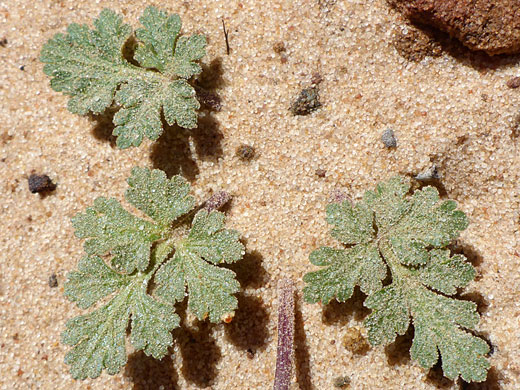Cymopterus Newberryi, Sweetroot Springparsley
Plants > Wildflowers > Apiaceae > Cymopterus Newberryi
Common names:
Sweetroot springparsley, Newberry's spring-parsley
Family:
Scientific name:
Cymopterus newberryi
Main flower color:
Range:
South Utah and north Arizona
Height:
Between 3 and 7 inches
Habitat:
Sandy places in semi-desert areas, and pinyon-juniper woodland; 3,500 to 7,000 feet
Leaves:
Mostly basal; pinnately divided into lobed leaflets
Season:
April to May
Leaves of cymopterus newberryi grow mostly at the base, on long, reddish stalks. They are most commonly divided into three leaflets, each divided into three smaller, round-lobed segments. Leaves and stems are glandular, somewhat sticky, and as the plant grows mostly in sandy locations, their surfaces often have a sandy covering. Leaf segments are usually wider than they are long.
The small, greenish-yellow flowers have five petals, five exserted stamens and one pistil; they become creamy-orange as they wither, and are replaced by flatted green fruits with winged, lighter-colored margins. The compound umbel has between five and 16 rays, different in length; the longest is about 1.4 inches. Individual clusters are subtended by relatively large, dark green bractlets, protruding beyond the flowers. The common name, sweetroot springparsley, reflects the fact that the roots are edible, pleasant to the taste; they were traditionally eaten by the Hopi peoples of northern Arizona.
The small, greenish-yellow flowers have five petals, five exserted stamens and one pistil; they become creamy-orange as they wither, and are replaced by flatted green fruits with winged, lighter-colored margins. The compound umbel has between five and 16 rays, different in length; the longest is about 1.4 inches. Individual clusters are subtended by relatively large, dark green bractlets, protruding beyond the flowers. The common name, sweetroot springparsley, reflects the fact that the roots are edible, pleasant to the taste; they were traditionally eaten by the Hopi peoples of northern Arizona.
All Contents © Copyright The American Southwest | Comments and Questions | Contribute | Site Map




